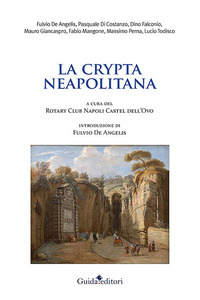La crypta neapolitana
by De Angelis Fulvio Di Costanzo Pasquale Falconio Dino Giancaspro Mauro Mangone Fabio Perna Massimo Todisco Lucio
Object over the centuries of an enigmatic and complex literary tradition, which has made it one of the most famous topoi in the Phlegrean area, described and taken up by artists from all over the world, the Crypta Neapolitana currently represents a forgotten place, as forgotten is the aura that enveloped him for centuries. On the other hand, to a large extent it hasn’t been visited for years.Born in the 1st century BC designed by the architect L. Cocceio Aucto, as part of a series of infrastructural interventions aimed at the strategic strengthening of the communication routes and water supplies between the city of Neapolis and the Campi Flegrei, it was the subject of subsequent improvement interventions by Alfonso of Aragon, of Don Pedro of Toledo, of Charles of Bourbon and of Giuseppe Bonaparte, and was a very busy communication route between the city and the Campi Flegrei, until its closure at the end of the nineteenth century, replaced by a gallery at lower down, the current Quattro Giornate tunnel.The literary tradition was uninterrupted, which from the first century BC to the end of the nineteenth century testified to a lively interest in the Crypt and in the tomb of Virgil, making the site an obligatory stop for travellers, poets and scholars, despite the difficulties of reaching it through a long route on the side of the Posillipo hill, along several steep paths between bramble bushes and vegetable gardens.The place was for decades at the center of the Piedigrotta festivals, which revived the pagan rites dedicated to the god Priapus, transferred to the cult of the Madonna. From 1930, on the occasion of the twentieth centenary of the birth of Virgil, the current access to the park was created and the remains of Giacomo Leopardi were moved there. Since 2014, the Rotary Club Napoli Castel dell\’Ovo has been activating a series of initiatives and long-term projects for the promotion of knowledge of the Crypta Neapolitana, in harmony with its physiognomy, linked to the values of civilization and culture of Magna Graecia and Greco-Roman Naples, wanted by its founder Giovanni Lazzara, with concentric programs: for the reopening of the Crypt to the public, for building a pedestrian and cycle path, for making it a cultural asset to be managed with a shared governance between public and private, for giving , in short, a new urban sense to those seven hundred meters of Roman tunnel dug into the tuff. This publication, dedicated to the themes that substantiate the projects of the Rotary Club Napoli Castel dell\’Ovo, is one of the fundamental stages of a journey that starts from the effort to make the Crypta Neapolitana known above all to the Neapolitans who know little or nothing about it.
- Publishing house Guida
- Year of publication 2022
- Number of pages 96
- ISBN 9788868669164
- Foreign Rights Diego Guida
- Price 12.00
De Angelis Fulvio Di Costanzo Pasquale Falconio Dino Giancaspro Mauro Mangone Fabio Perna Massimo Todisco Lucio
Mauro Giancaspro (Naples 1949) directed the State Library of Cosenza for ten years and the National Library of Naples for nineteen years. He collaborates with newspapers and magazines, mainly interested in reading, communication and contemporary art.






